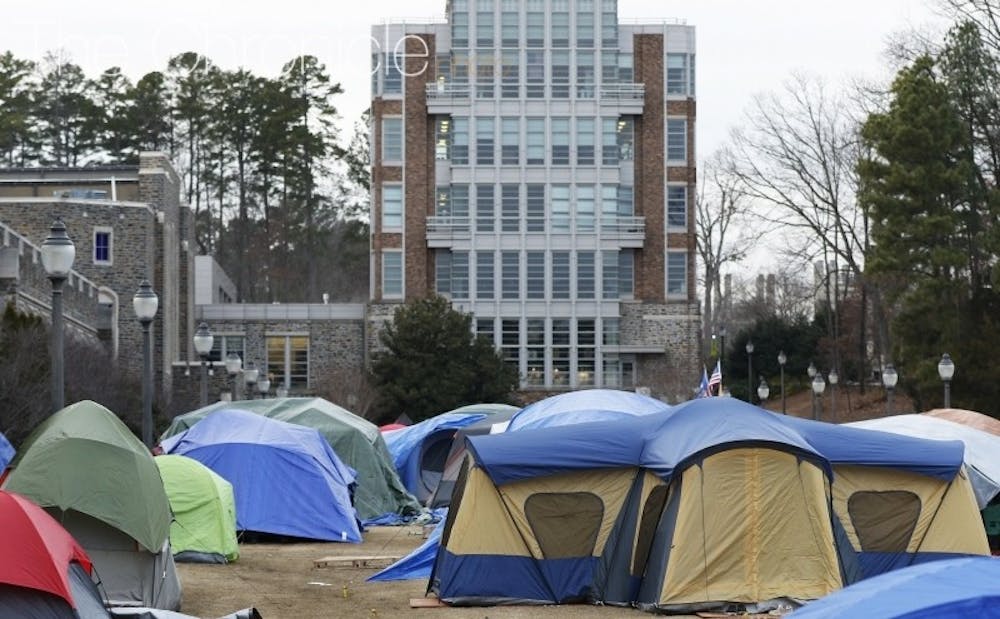Tenting has been a phenomenon on Duke’s campus for over 30 years. Beginning in 1986 with a group of friends who just wanted one of the best spots for the Duke vs. UNC game, the practice of tenting exploded into the intricate and complex system of checks and balances that we know today. The tenting groups are heavily regulated and monitored by the line monitors to ensure that everyone is following the tenting rules accordingly. As many know, there are varying levels of tenting: the black level, the blue level, and the white level. A couple of weeks ago, the line monitors rolled out a new approach to determining who was eligible to white tent and—in replacement of the walk-up line—flex tent. As for any other complex methodology, it is important to analyze the procedure put into place to evaluate its systematic integrity. Essentially, we must ask, “Did the methodology put forth by the line monitor committee demonstrate both honor and integrity?”
In a normal scavenger hunt style, the race to earn a spot as a white tent consisted of finding various locations via cryptic clues. The logic behind developing a line was the same: those groups to find the locations first would be placed higher on the list than the others; the first thirty groups to find the spots would earn spots as white tents, and the remaining thirty tents would earn spots as flex tents. Instead of just doing one spot as they have done in years past, the line monitors chose to have six different locations. This meant groups had to spread out across campus and have different members check in at each location. Immediately, it sounds like a complex methodology.
During a recent talk regarding scientific integrity, Geeta Swammy, vice dean and associate vice provost of scientific integrity, discussed the importance of upholding integrity throughout a research or field procedure. As with any procedure seen within the research setting, certain protocols are required to ensure maximum safety and reproducibility and to minimize the amount of potential errors. This scavenger hunt did not seem to meet these criteria, and therefore seemed to be less thoroughly developed. In consequence, confusion and disorder ensued throughout the hunt.
Because there were multiple locations that group members were required to check in to, the line monitors had to factor in the order of each group at each location in their final time/score. This differs greatly than having just one location in which the line formed would translate directly into the list of groups earning a spot to white tent. The increased complexity would require a way in which the time each individual group member arrived at each station was factored in some cumulative time or score, in order to rank all of the groups. From there, then the line monitors could determine the list. Once the scavenger hunt was underway, the line monitors failed to take into account the long queues that developed due to poor staffing at each station. Furthermore, the way in which the line monitors dealt with the situation was faulty: stations had line monitors write numbers on the group member’s hand to keep the line in order. This did not take into account the actual time at which the groups were able to locate the spot. This meant the time of certain groups at certain stations were inherently skewed due to lack of oversight. It became obvious that this was clearly going to affect how the order of the lines were determined, requiring an even more intricate calculation in order to generate the list as accurately as possible. Bottom line: it seemed as if the methodology was not thoroughly analyzed, checked and tried like any other procedure should be prior to its implementation.
It is valid to see this application of scientific integrity on the white tenting scavenger hunt as a stretch; they are two very different fields that would produce very different consequences if the methodology were never double checked. However, tenting is an integral part of student life here at Duke. The UNC vs. Duke basketball game is one of the biggest events that occurs on campus in the spring. The rivalry runs deep, and proud Duke students want to cheer their team to victory. With Cameron being as small as it is, there has to be a way in which students are admitted into the game, placing a lot of weight on the integrity of tenting as a system.
Clearly, tenting is a constantly growing and increasingly complex system. If Duke wants this system to flourish fully in light of its increasing growth, figures of authority must find ways to perfect its methodology to ensure the system is one of honor and integrity. Each part of the tenting process should be evaluated critically and meticulously in order to produce a system that match its growing popularity and intricacy. The scavenger hunt is just a single outside-the-classroom example where integrity is most important. Honor Council strives to promote a community of honor on Duke’s campus and the world of tenting falls in our domain. We encourage students and line monitors alike to keep the Duke Community Standard in mind each year during the tenting season to ensure we uphold our community’s values.
This article was written by Trinity sophomore Cliff Haley IV, who is also a columnist for The Chronicle.
Get The Chronicle straight to your inbox
Sign up for our weekly newsletter. Cancel at any time.
Kushal Kudakia, President of Duke Honor Council, is a Trinity junior. his column for Duke Honor Council runs on alternate Fridays.

